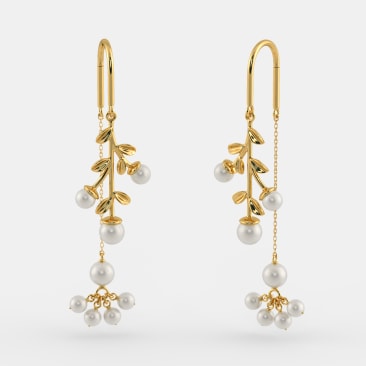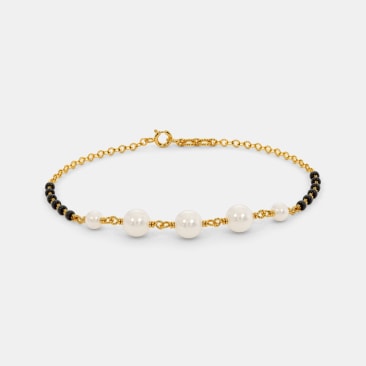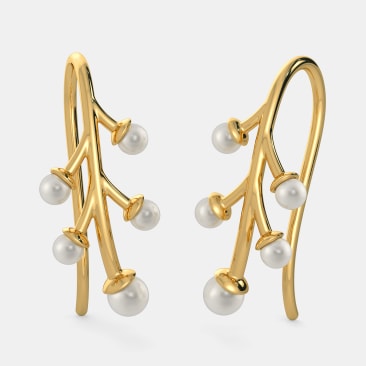Pearl
It is said that pearls are gems fit for a queen and rightly so. Their elegant lustre makes these gemstones an eternal classic favoured by women of all ages. For centuries now, they are said to reflect a person’s wealth and social status. Here is everything you should know about pearls – their history, types, use, and caring and buying tips.
Overview
Unlike other gemstones which are mined from the earth, pearls are made by living creatures i.e. shelled mollusks. They are proof that anything can be transformed into something beautiful. It its chemical composition, these gems are composed of calcium carbonate which is deposited inside the mollusk in concentric layers. They are not hard gems – on the Mohs scale, they have a hardness of about 4.5. This means, pearls are only half as hard as diamonds or rubies of the same carat value. These aquatic beauties are available in a variety of colours, shapes, and sizes and may be used for making all types of jewellery such as pearl bangles, rings, necklaces, etc. The largest pearl known to man is called the La Peregrina. It weighs 454 carats.
History of Pearls
The first mention of natural pearls goes back to 2300 BC. History has it that the Chinese royalty of this era presented pearls as gifts. Since pearls were said to symbolise social status of the wearer, in 1 BC Julius Caesar passed a law in Europe that said that only the ruling classes could wear pearls. There are many myths and stories that surround pearls. It is said that knights wore pearls while going to war believing that it would keep them safe. According to another popular legend, Cleopatra crushed a large pearl in a glass of wine to prove that she could give the most expensive dinner. In India, these white beauties were an integral part of many a king’s and queen’s jewellery collections, especially during the Mughal period. The quintessentially Indian Chand Bali earrings are a fine case in point.
Pearls were so popular in the fifteenth and sixteenth centuries that these periods are also known as the Pearl Age. The first cultured pearl was created in 1893 by a Japanese entrepreneur named Mikimoto Kokichi. Today, most of the pearls used in jewellery are cultured pearls.
How Are Pearls Formed?
Pearls are made by oysters and that’s why Federico Fellini called them “the oyster’s autobiography”. They are the result of these sea creatures’ defense mechanism against irritants that enter the shell. When sand or a parasite enters the shell, it is coated with a fluid. Layers of this fluid are then slowly built upon this irritant. This layering is known as the nacre. The thicker the layer of nacre, the higher the quality of the pearl will be. It can take a minimum of three years for such irritants to be transformed into a pearl under natural conditions.
Types of Pearls
Pearls can be classified on the basis of how they are formed, colour, and shape. Here is a quick overview of each category:
Natural vs. cultured: Pearls that are formed naturally are known as natural pearls while those that are formed with human assistance are called cultural pearls. In case of the latter, an irritant is forcefully introduced inside an oyster. On other words, cultured pearls are created under controlled conditions with human aid. This doesn’t mean that they are artificial or faux. Natural pearls and cultured pearls have the same properties.
Freshwater vs. seawater: Cultured pearls can be further divided into two- freshwater pearls and seawater pearls. The latter generally are rounder in shape and have better nacre as compared to their fresh water counterparts.
White vs. coloured: Pearls are generally pictured as white or off-white gemstones. However, they are available in a range of other colours as well. Pearls may be black, grey, silver, pink, green, blue or even purple. The colour of a pearl is influenced largely by the host mollusk and water conditions. No two pearls ever have exactly the same colour.
Round vs. shaped: What’s the first shape that comes to your mind when you think of pearls? Round, right? Round pearls are the most prized variety available in the market today. This doesn’t mean that pearls are only round in shape; they may also be oval, button-shaped, and droplet-shaped. Irregularly shaped pearls are known as baroque pearls.
Birthstones and Anniversaries
Pearls are the birthstone for those who are born in the month of June. If you are born under the zodiac signs of Gemini and Cancer, a pair of pearl earrings or a gold ring studded with pearl is your perfect pick. Besides this, pearls are also associated with the third and thirtieth wedding anniversary. In India, these white beauties are called ‘motis’ and are associated with the Moon.
Real Pearls vs Fake Pearls
Like any other gemstone, look-alike pearls may also be synthetically manufactured. So, how do you know if a pearl is real or fake? Real pearls, whether they are natural or cultured, are heavier than fake pearls. They also a smooth drill hole without any chipping. It is also important to remember that two real pearls are never exactly alike and perfectly round pearls are rare. If you rub real pearls on your teeth, they should feel gritty. However, be careful if you decide to test pearls this way as too much pressure could damage them.
How to Buy Pearls?
Today, you can buy a wide range of pearl ornaments including rings, earrings, necklaces, pendants, and bangles, among others. When buying pearl jewellery, you must pay attention to the size, colour, shape, lustre, nacre quality, and the surface of pearls used on it.
Size: The size of this gem plays an important role in determining the price of the jewellery you buy. As a general rule, the larger a pearl, the more valuable and rare it will be.
Colour: There are three components to the colour of a pearl - the body colour, overtone, and the orient. The overall colour of the pearl is known as the body colour. Overtone refers to the translucent colours that may appear over the body colour. Rainbow colours that appear on or just below the surface of a pearl are known as the orient. The value of pearl colours changes according to fashion trends.
Shape: Round pearls are the most valuable ones in the jewellery industry. In addition, well-defined oval, drop, and large baroque pearls are also valuable.
Lustre: A pearl’s lustre is its most important quality. If the reflections are sharp, it is said to have excellent lustre. On the other hand, if a pearl has dim, diffused reflections, it is said to have poor lustre.
Nacre quality: Nacre and lustre are closely related. The higher the nacre, the more the lustre will be.
Surface: Pearls are natural and hence their surface is never perfect. Characteristics such as ridges, scratches, and flattened sections are commonly seen on natural and cultures varieties of this gem. If these are severe, it can affect the value of the pearl.
How to Look After Your Pearl Jewellery?
Pearls are delicate gemstones that need special care. Here is a list of things you can do to keep their sheen forever:
- Limit their exposure to creams, lotions, perfumes, acids and all other chemicals.
- Do not wear pearl bracelets, bangles or rings while doing any kind of manual work or while you clean your home.
- When not being worn, store your pearls in individual fabric-lined boxes.
- Do not store pearls in plastic bags or with any other jewellery. Remember to fasten clasps and pins before your store them as their edges could scratch the pearl surface.
- To keep your pearls clean, wipe them with a soft cloth after you take them off. Avoid harsh chemicals and brushes that can damage the surface of the pearls.
- Also, avoid cleaning your pearls with ultrasonic cleaning machines.
- Pearl strings should ideally be restrung annually or biannually.
Pearls are nature’s best gifts to jewellery lovers. When nature gives us its best, shouldn’t we make the best use of it? So, own a pearl trinket, wear it with pride, and keep it with care!




